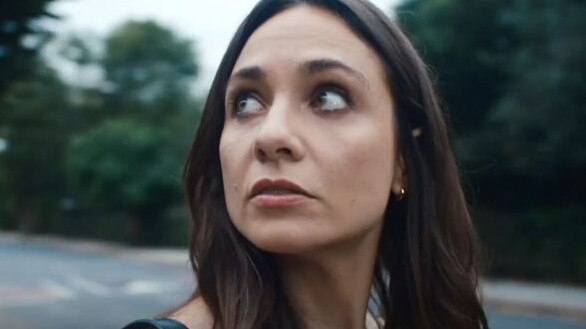Marriage thrills in domestic noir Our House
A wife comes home from a weekend away to find her house emptied of her belongings in gripping new series Our House.

Our House is adapted from the international best-selling novel by British author Louise Candlish, a Sunday Times bestseller and also crime book of the year at the British Book Awards in 2019. The four-part series is created by screenwriter Simon Ashdown (Funland, EastEnders) and produced by Britain’s Red Planet Pictures (Sanditon), with Sheree Folkson (Penny Dreadful: City of Angels) directing.
A marriage thriller, it soon edges, as the twisty plot unfolds, into a kind of domestic noir, a story where spouses become unknowable, and marriages shift beyond repair.
It’s built around the notion that everyday life can sometimes turn catastrophically as events happen out of nowhere, catapulting lives into something ominous, grievous and disturbing. The novelist Julia Crouch came up with the definition of it a few years ago: “In a nutshell, domestic noir takes place primarily in homes and workplaces, concerns itself largely (but not exclusively) with the female experience, is based around relationships and takes as its base a broadly feminist view that the domestic sphere is a challenging and sometimes dangerous prospect for its inhabitants.”
In this series, well conceived by Ashdown, the middle-class home becomes paradoxically a place which should feel safe and reassuring but instead becomes horrific. The drama turns and spins on the question of secrets and lies between husband and wife, the truth of the emerging mystery inextricably tied to their marriage. And that house.
Candlish conceived of the novel after reading an article about a woman who had almost been the victim of property fraud, in a not dissimilar scenario to the one she uses in the book. And was struck by the idea of how a home seemed to have such a high emotional resonance for people, many of whom seem obsessed with property. “Partly because of the political climate and the uncertainty of the outside world, we’re all kind of looking inward, setting such emotional store in our domestic life,” she says. “But the other reason is that our houses have gone up in value so much that they’ve almost taken on a dangerous kind of central role in a family. In so many situations now, I think a family home is making the decisions for families rather than the people.”
Our House finds Fiona Lawson (Tuppence Middleton, Mank) in such a place. She and her husband, Bram (Martin Compston, Line of Duty), live in the home they own at 91 Trinity Avenue, and its skyrocketing value has made them accidental millionaires. But their lives are suddenly altered, possibly irreparably. After a weekend away Fiona walks home to find a furniture removal van outside and her house emptied of her belongings. A strange woman is holding the keys and a contract of sale with Fiona’s signature attached. The new owners are also baffled.
We cut back in time to 10 years earlier when the couple take occupancy, the grand house suddenly the material backdrop to the narrative of their lives and that of their two young boys, who arrive as they keep renovating. (The nagging question is how they afforded this magical double-fronted London house in the first place, a question that is not answered.)
Suddenly it all falls apart when she arrives home one night and finds Bram making out with their neighbour Merle (Weruche Opia, I May Destroy You) in the kids’ playhouse.
Back in the present, Bram seems to have disappeared, along with the children, a situation that creates one of the cliffhangers at the end of the first episode. While in the past, we follow them as they try to find a way to “ease the transition” to divorce, for the sake of the children. They have come to a “bird-nesting agreement”, renting a somewhat seedy nearby apartment and trading off nights at the house with the children. But Fiona begins to discover her husband’s lies and cover-ups just as we begin to suspect he isn’t the only one hiding something.
Then, still in the past, something truly menacing and alarming happens.
It’s expertly set up by Ashdown, who handles the juxtaposition between the past and present adroitly and keeps the suspense tightly controlled. We are always asking not so much what has happened, though that is important as the layers of the past are revealed, but what will happen next. He gives us the story as an iceberg, most of its substance still invisible beneath the surface, until suddenly unexpected things happen. And they certainly do. The acting is spot on. Compston nicely balances a kind of larrikin attractiveness and small-guy charm with a subtle secretiveness, while Middleton brings an ingenuousness that’s beguiling although you constantly sense there is something unreliable about her.
Folkson, an experienced director, with credits as diverse as Pennyworth and Bridgerton, is in fine control, too, her work with director of photography Richard Mott carrying a kind of visceral energy that helps drive the suspense.
Candlish says when she wrote the novel in terms of characters, she watched “a whole sort of season” of Barbara Stanwyck movies such as Double Indemnity, influenced by “the way a simple crime always led to a crime that covers up a crime that covers up the crime before”. And this is the tantalising structure that Ashdown and Folkson present us with here too.
Murder in Provence is far less suspenseful but in its oddly affable, cordial way is quite enjoyable. It consists of three feature-length films based on the best-selling detective novels by M. L. Longworth, the first season covering three cases of murder and misdemeanours in Aix-en-Provence and its agreeable surroundings.
Longworth is a Canadian-born author who has lived in and around Aix for some decades and the series is based on her best-selling Verlaque and Bonnet series of detective novels. Judge Antoine Verlaque is the dapper and seductive chief magistrate of Aix, and his on-again, off-again love interest is law professor Marine Bonnet. They live apart but are constantly together, neither fully reconciled to their pasts it seems – Marine’s former husband was abusive and Verlaque’s alcoholic wife drowned herself in the ocean.
The novels have been well received by critics, Booklist calling them “mysteries for foodies, with the plot providing a table upon which enchanting meals and accompanying wines are served”. And the great crime reviewer for The New York Times, Marilyn Stasio remarked, “So many bottles, so many lovely views. A reader might be forgiven for feeling woozy.”
Longworth says she had never sat down and written a mystery, nor read very many, and she doesn’t do violence in her novels. “But I did devour all of Donna Leon’s from the beginning of her mysteries set in Venice. And the Inspector Morse series set in Oxford. And both of those towns remind me of Aix in size and beauty. You know, it’s a bit of everything. It’s armchair travelling. It’s a mystery, and I’ve always liked the puzzle of mysteries.”
Her blog is a beautifully written delight, too. “There is real attraction in setting a mystery series in a village, town or small city, especially a quaint one: the small size means that everyone knows everyone else’s business,” she says in one entry about writing her books.
“And the writer can indulge themselves with descriptions of streets and buildings that they know well, either because they live there, like Dexter did in Oxford, or because they’ve imagined the whole thing up.”
The series was commissioned by BritBox, the streaming partnership between the BBC and ITV, and stars that rather unique actor Roger Allam (The Thick of It) as Verlaque and the versatile Nancy Carroll (Father Brown) as his paramour Bonnet. Verlaque is assisted in his investigations by the loyal police deputy commissioner Helene Paulik (Keala Settle, The Greatest Showman). And Patricia Hodge is a delight as Florence Bonnet, Marine’s busybody mother. It’s adapted for the screen by renowned playwright Shelagh Stephenson (Downton Abbey), and ably directed by Chloe Thomas (Victoria).
The case itself, involving the murder of a fine arts university professor, seems somewhat incidental to our central characters enjoying their time in Aix. The academic, somewhat mysteriously and callously, decided he would no longer retire as department head at a function at which he was to announce it. This is after promising a number of his proteges his tenured position, which is not only well remunerated but also involves a luxurious apartment.
He’s found dead the next morning with a blunt trauma wound to the head – the result, it turns out, of a whack from a priceless 14th-century wooden carving of Saint Francis.
The investigation mooches cosily along, a case really of many suspects being questioned and many rooms being searched and a few bottles of wine being opened. It’s not so much a cop procedural as a rather pleasant travelogue, acted by some highly professional and watchable performers, who remain resolutely British despite their very French backgrounds and heritage.
Suspension of disbelief is relatively easy in their case.
Our House, streaming on Binge.
Murder in Provence, streaming on Britbox.




To join the conversation, please log in. Don't have an account? Register
Join the conversation, you are commenting as Logout